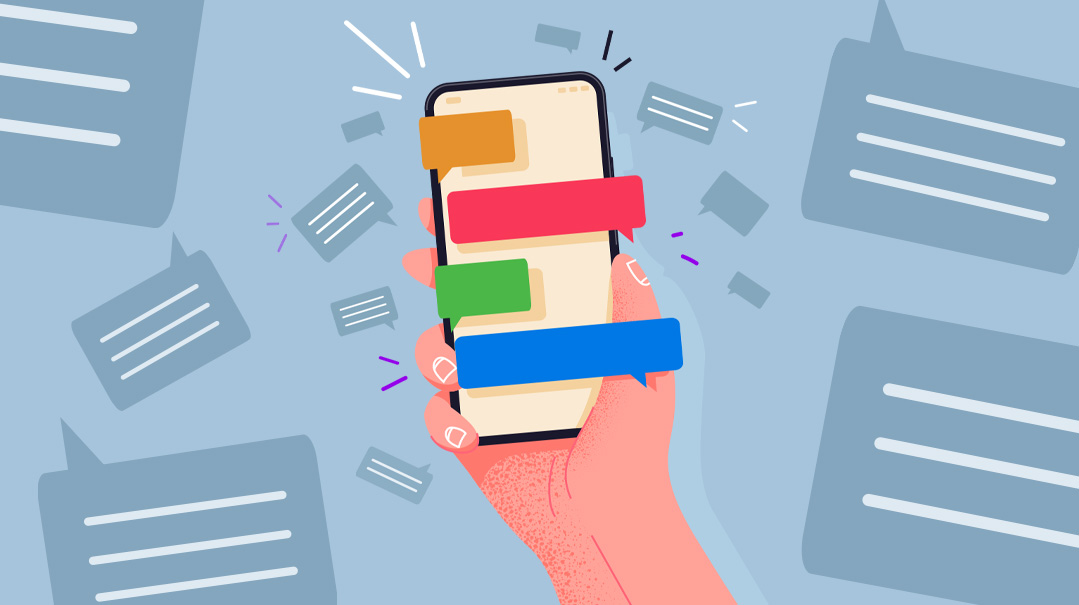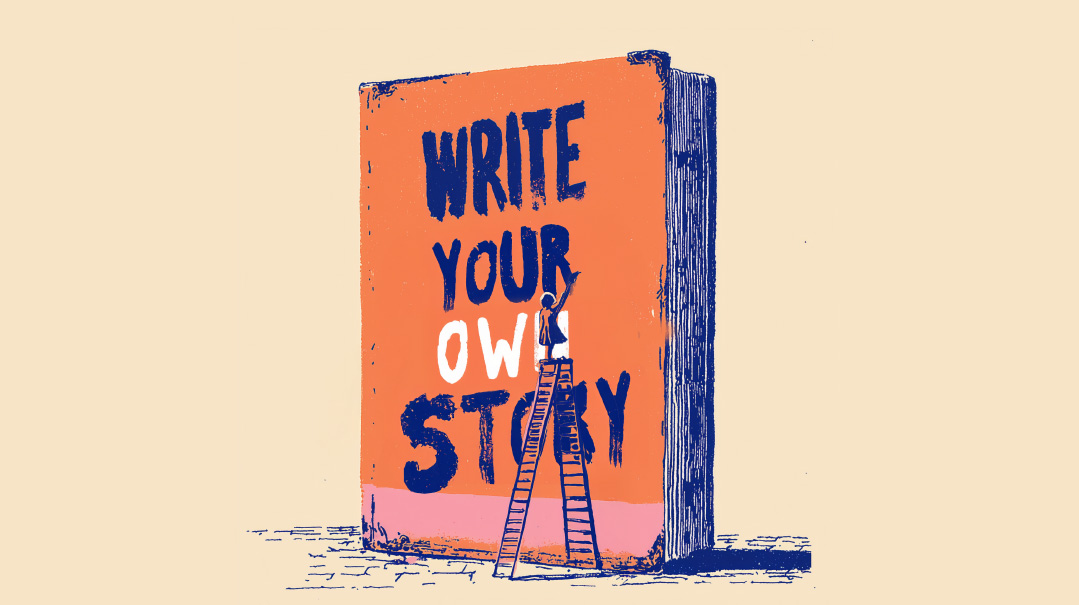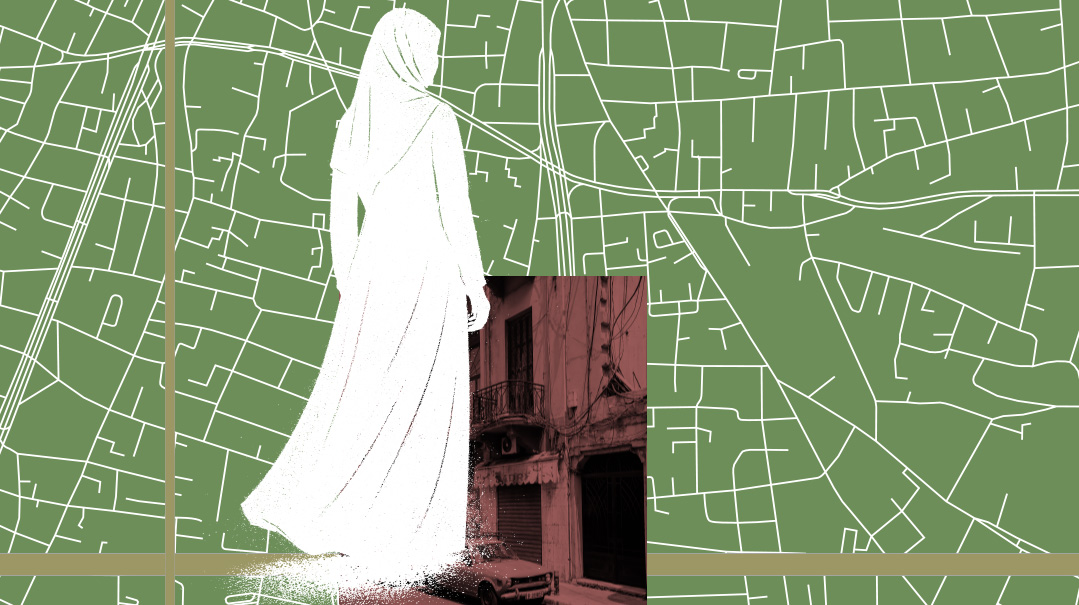A Month of Control
| September 6, 2022Five women find freedom from their phones

What’s the first thing you touch in the morning and the last thing you see before you drop off to sleep? For far too many of us, the answer is our phones. Five women said “Enough!” and actively took steps to disconnect from their device and reconnect with what matters
Researcher and author Catherine Price remembers when it hit her: She was feeding her baby, and while her baby was looking into her eyes, Catherine was looking at her phone’s screen. She knew then that something had to change.
She started thinking seriously about the ways we interact with technology.
“I realized that if you add up the hours that we spend each day interacting with our phones, tablets, laptops, and desktops, many of us are spending the majority of our waking lives staring at a screen,” she says. “Sure, much of this screen time is useful or necessary. But there are a lot of other times when our screens distract us from things that are truly important to us — whether it’s the people we love or the activities that bring us meaning and joy.”
Price was inspired to write How to Break Up with Your Phone. In the first part of the book, she explains how phones are designed to be addictive, providing the science to back her up. The second part of the book is a 30-day plan to undo phone addiction and reduce the amount of time spent mindlessly on your phone.
We challenged five women to read her book and share with us how her plan worked for them. Here are their stories.
Chana Rochel
50, undergrad psychology/medicine
Iwas born in 1971, and for the first 35 years of my life, I did everything myself, without the help of a phone. Then came the information age, and I got a smartphone. It was a gradual process, but I found myself using my phone all the time.
I was on Instagram, Facebook, and WhatsApp. I had reasons for using each. Facebook helped me keep in touch with family, Instagram gave me all kinds of cooking and organizational tips, WhatsApp was important for communication.
When Family First invited me to take this challenge, I wanted to see if I could cut out Facebook and Instagram. I knew it wasn’t going to be possible to eliminate WhatsApp.
The first week, I did my own research on technology and how it affects us as a society. One of the things that came up was how the corporate heads of tech companies don’t allow their children to have any devices. Price mentioned that in her book, but I learned that those executives have their children partake in other activities, like horseback riding, art projects, and piano.
That’s where I wanted to be. I don’t want to rely on my phone; I want to be free, same as those children.
The next week, I went to TAG and filtered my phone. TAG allows you to choose what you want to keep, and it was important that my phone not be completely restricted. I use it for grocery shopping. But I knew I wanted Instagram and Facebook gone. I also blocked YouTube and unsubscribed from entertainment sites.
I’m in upstate New York now, and I don’t have a printer, so I went to the library to take care of my returns, and while I was there, I checked Facebook and Instagram. Afterward, I realized that going to the library to take care of this was an errand, with a specific time and day. On my phone it was a distraction, but this way, I felt more focused, even as I checked those platforms.
To track my phone usage, I set up an app tracker. When I started this project, I was using my phone six hours a day. Now, I’m down to four hours. The tracker shows how much time you spend on your phone, and which apps I use, so I take that into account. I know that those four hours might include listening to TorahAnytime or Spotify as I clean my house. I’m okay with that.
I finished the 30-day plan and I’ve made the decision to continue this through Elul, and I intend to keep at it even afterward. I want to go back to life before I had my smartphone. If I need to access something I can’t get on my phone or computer, I’ll go to the library. I might even delegate my shopping and email to specific days of the week.
This project taught me balance. It gave me back my time — I finished two needlepoints and a crochet project. I also want to go back to the book. This project spurred me to buy A Daily Dose of Bitachon, and I’m learning a portion every day.
Before taking on this challenge, I was always jumping from one thing to the next. Now I learned to stop, breathe, and be.
Note: Three weeks after completing the 30-day plan, Chana Rochel cut down her screen time to two and a half hours a day.
Bracha
33, nurse
When I read Price’s book, I learned that while phone companies advertise their benefits, their executives never allow their families the use of that tech. That scared me and brought home the idea that family comes first.
Why should the little people in my family think of me with a phone in my hand? I thought. On Shabbos, I sit with my kids and tell them stories. I want to be able to do that all the time.
The book sets up a daily plan for 30 days, but my summers are hectic, and I couldn’t devote time each day to taking on an additional boundary, so I did each week’s boundaries all at one time, over four weeks.
Cutting back my phone usage was about reducing my time on Instagram, where I’d mindlessly scroll through other people’s lives. But I couldn’t get rid of Instagram completely. I live out of town, and I shop through the app.
To reduce my usage, I moved Instagram to the back page of my phone. I also made myself parameters: I could open the app twice a day for a total of 20 minutes. (My goal is to delete Instagram entirely, and I hope to do that within the next month. After I delete the app from my phone, I’ll let myself use it on Safari, but with these limits.)
Once I moved Instagram to the back of my phone, I became more active. I went for walks, went bike riding.
Another thing I did was keep my phone on silent. I missed a lot of calls, from work, my kids’ school, a doctor, but people were very understanding when I told them I am prioritizing my family. I also turned off notifications from WhatsApp — and I don’t feel like I’m missing anything. I talk to my mother and my sisters on the phone and get my news that way.
As part of this project, I started tracking my phone usage and discovered I had an average of 195 phone pickups per day. I was so upset. It’s not possible, I thought.
Then I started noticing how I excused myself every time I picked up my phone: I need it for work, or I need it for shopping. Now, when I find myself reaching for my phone, I say, “Let me think things through.”
The phone isn’t something that calms me. In fact, looking at it riles me up, and prevents a good night of sleep. I stopped scrolling before bed. Price suggests charging the phone outside the bedroom. I still keep mine near me at night, because when I get up to feed my baby, I don’t want to fall asleep in the middle of the feeding.
I love getting the weekly notification where it says I’ve cut my screen time. Through this project, I reduced my phone hours to about three and a half hours from five hours per day. Of that, a lot of that time is my kids scrolling through our pictures.
This project made me think, feel guilty, and become more cognizant of my screen time. I don’t want my kids to remember me with the phone. My takeaway is that family is above all.
Back in school, our teachers advised us to hang up the phone when our husbands come home; I think that rule should be expanded to include your kids. They hate when you’re busy with your phone. We tell our kids that screen time is bad for them. What about ourselves?
Note: As of now, Bracha has deleted Instagram. It’s been three weeks, and she hasn’t checked it once.
Nechie
38, artisan baker
I
found Price’s book to be eye-opening. It made me think more deeply about things I’d always known.
For example, she talks about how the phone becomes an obsession. We reach for it even when there’s no reason. We take it everywhere. We grab it as second nature. If we leave the house without it, we run back home to get it. The phone has made us unable to focus too long on one thing. Instead, we need constant stimulation.
I didn’t follow the book’s daily plan. I read through it all at once and did it my own way. Much of her plan involves apps I never had, like Instagram, and games, the apps she calls time-wasters. I do have WhatsApp, which I use to run my business.
Still, this project made me stop and think. I started asking myself, Why am I grabbing my phone? Why am I doing this to myself?
Over the month, I changed my morning schedule. When I wake up, I wash negel vasser, I drink my coffee, and only check my phone afterward. I’ve discovered that I don’t miss anything. What I need to know will find me, and it’s okay if I don’t get things like the Rosh-Chodesh-white-shirt reminder until after my kids are gone. If it’s important to me, I’ll write myself a note.
This project also inspired me to practice being still. I found time to sit on my porch, look at the sky, the flowers on my railing, and take it all in. I found myself thinking, Wow! Why would I need or want my phone now? I realized we are afraid to be alone.
Now I want an alarm clock in my room, instead of my phone’s alarm clock. I plan to keep my phone in the kitchen to charge, like Price suggests.
One theme that kept coming up in the book was how we waste so much time on needless scrolling. Wha tsApp is a big part of my wasted time. My excuse is work, and I’m trying to see if there’s another way for me to run my business, maybe through a website. I find that once I’m on my phone, I get distracted, and I’ll start scrolling.
I started to keep my phone on silent. No more pings; I don’t want to hear that noise, feel that pull that makes my brain perk up. I started telling people, “If you want me, call me.”
I’ve reduced my average phone time by three hours through this project. Price writes about how we’ve become dependent on our phones, almost like we need it for our hearts to beat. I try to focus and not reach for it. I’m more mindful, and I’ve become aware of how much time gets lost.
When I’m around my children, I’m even more careful. Kids learn by osmosis, by what they see their parents say and do. I try not to be on my phone when they are around. I want to be there for them. My phone shouldn’t stand in their way.
Technology is here to stay. Further advancements will fool us into getting lost in them. We need to make a conscious decision not to allow our phones to take over, causing us to lose out on so much in our lives.
Aliza
44, kallah teacher
S
ome people are very good with structure. I’m not. When I took on this challenge, I knew that Price’s daily plan wouldn’t work for me. Instead, I picked different tactics that did work for me.
The book was an eye-opener because it wasn’t coming from a religious standpoint. The way we interact with our phones is unhealthy across the board. I knew apps are developed to be addictive, and that it plays with the dopamine rush, but reading it from a secular perspective was compelling.
My phone is fully blocked, and I don’t have social media, but I became more aware of other things. Like my screen time. I stare at a screen way too often. I stopped taking my phone with me wherever I went. When I was at the pool, I left it in my bag. I didn’t take it to our Tehillim circle, and if I went to sit outside with friends, I didn’t bring it.
The first few times felt weird, but then it became liberating — and exhilarating as I saw my screen time drop. The first week it went down by 50 minutes, the next week 70 minutes, the week after by 80 minutes.
Most of my screen time is spent on WhatsApp. I really want to delete WhatsApp, but it’s useful to me professionally. That’s my main excuse. Now, my daughter downloaded Google Voice for me, and I plan to use it to limit WhatsApp to specific chats. I also moved WhatsApp to the back screen of the phone and muted it. Out of sight, out of mind — I forget to check it, and now I don’t even know when I get a WhatsApp message.
I’ve begun to put my phone down when my kids talk to me. I want to give them my full attention. I put my phone away during bedtime. I also stopped checking my phone in the middle of the night. My next step is to charge it outside my bedroom.
It’s hard. When the kids want me to take pictures of them, they’ll get my phone, but then while I’m taking a video, something pops up, and I’m drawn in. I also found that we are forced to open our phones in the morning. There are texts about bus delays or things the kids need for the day. For example, this morning I didn’t look at my phone until after my kids left for day camp, so I missed the text telling me that they’d need bathing suits.
I’d been feeling like I’m distracted so easily, and my ability to do one thing at a time is gone. I thought it’s because I’m getting older, but through this project, I discovered that it’s because of the phone. That bothers me.
When something bothers you, you need to listen to your nagging inner voice and do something, or that voice quiets. This project gave me a good awareness that setting boundaries is not a maybe, but a must. Without proper boundaries, phones can lead to an unhealthy lifestyle. We lose out on our most magical moments. We lose real connection with the people we love most.
Note: Two weeks after completing the plan, Aliza has days where her screen time is just over an hour.
Devorah
45, teacher
This is my second time on the plan. I don’t see that as a failure. I think we all need to be vigilant, or our phone time creeps up. I cut back significantly when I used the plan four years ago, but my phone time crept back up during Covid, when I needed to be in touch with my children’s classes. I also reinstalled Instagram, which I had previously deleted, because my exercise instructors were giving classes on that platform.
Doing this the second time around is different. I still have a lot of the healthy habits I incorporated the first time around. For example, I don’t charge my phone in my bedroom or relax before bed by scrolling. I’ve removed apps I don’t use and moved my biggest time wasters into folders so that the icons are smaller and less enticing. I keep those folders on the last page of my phone’s screen. I also keep my phone on silent.
Still, I needed to cut back, and I had to think carefully about why my phone time crept up. I realized I occasionally use my phone when I’m bored or to distract myself. I became more mindful when I’d reach for my phone, and instead of scrolling, I chose instead to either talk to a friend, read a book, or just think.
For me, WhatsApp is a real obstacle to cutting my phone time. My family and friends use it to communicate, sometimes for important things. But WhatsApp is incredibly distracting. One of the things that bothers me most is the way it pulls me from whatever I’m doing and fractures my concentration. This was something I wanted to change.
I installed an app tracker on my phone, and set limits for screen time and pickups. I know that eventually people don’t care about violating the limits they set, but I was hoping I’d care long enough to set boundaries and create new habits. Next, while I still have WhatsApp on my phone, I installed WhatsApp on my laptop. I decided that if I needed to answer WhatsApp messages, it would be better to do it on a bigger screen that would force me to sit in one place, doing only that one task. It has definitely helped, but I fervently wish we’d all collectively give up WhatsApp.
I also deleted Instagram, and decided not to check my phone before seven a.m. That’s hard, because I’m an early riser, but I try to use the early morning time to read, which is another casualty of smartphones.
This past month’s efforts have paid off. I got my phone time down to an average of two and a half hours a day. I have also become more mindful when using my phone, and this has prevented mindless scrolling or toggling between apps to check for updates.
I still have work ahead of me, and I still plan to maintain vigilance when I use my phone. One of the things smartphones have taken from us is the ability to sit and think or daydream. I used to believe that was wasting time, but now that it’s so hard to get to that place, I just want to be able to do it again.
Scary Smartphone Facts
× Smartphones are designed to be addictive. Tristan Harris is a former Google employee who now works to raise awareness on how devices are designed to manipulate us. He says, “Your telephone in the 1970s didn’t have a thousand engineers on the other side of the telephone who were redesigning it… to be more and more persuasive.” The reason they increase their “user engagement” is because they make money off that engagement by selling your data profile.
× Phones take advantage of our psychological quirks in order to draw us in. Many apps have embedded algorithms that measure the most effective time to deliver a dopamine rush (for example, Instagram delivering a bunch of likes at once) to a specific user, to prevent the user from closing the app. This manipulation of dopamine is called “brain hacking.” People love reaction and feedback, and phones provide that in the form of links, and with the whoosh sound that accompanies a sent email or text. People also find unpredictability irresistible, and when we check our phones, it’s not because we’re sure something good is waiting, but because something good could be waiting. This keeps people checking their phones countless times a day. Phones also incite anxiety by providing new information every time we pick them up, so when we don’t, we worry about what we may have missed.
× The American Journal of Epidemiology looked at a group of people over time, trying to determine if social media use causes unhappiness. Their findings: “We found consistently that both liking others’ content and clicking links significantly predicted a subsequent reduction in self-reported physical health, mental health, and life satisfaction.”
× Smartphones claim they allow people to multitask, but the truth is that our brains can only do one cognitively demanding thing at a time. When people think they’re multitasking, they’re really “task-switching.” Task switching requires us to slow down, and engage in something new, which takes about 25 minutes. But phones hijack our attention and prevent us from focusing for those 25 minutes. This has changed the way we think and problem solve.
Adapted from How to Break Up with Your Phone
Setting Speed Bumps
Catherine Prices’s 30-day plan suggests setting up “speed bumps,” or small obstacles that slow you down and make you think in order to prevent you from scrolling mindlessly through your phone’s apps. Some of her suggestions include:
Download a tracking app
Most people’s estimate of their screen time and pickups is far lower than their reality.
Create a prompt to force you to pay attention
Notice how and when you use your phone, and how you feel when you do. Putting a rubber band around your phone, or a piece of tape on the back can be a physical reminder to pay attention when you reach for your phone. You could also set a visual reminder on your lock screen. Take a picture of a piece of paper that says, “Why?” or “What do I want to pay more attention to?”
Delete social media apps
Price suggests one check their account on a laptop where the app has fewer features and is less engaging.
Block notifications
Notifications act like the bell in Pavlov’s experiment. They tinker with our brain’s dopamine, and create the urge to check our phones any time we’re near them.
Change where you charge it
Don’t charge your phone near your bed. This will eliminate the urge to check it in the middle of the night.
Set up no-phone zones
There should be places in your home where you don’t bring your phone. The dinner table and your bedroom are two good places to set boundaries.
Adapted from How to Break Up with Your Phone
(Originally featured in Family First, Issue 809)
Oops! We could not locate your form.







